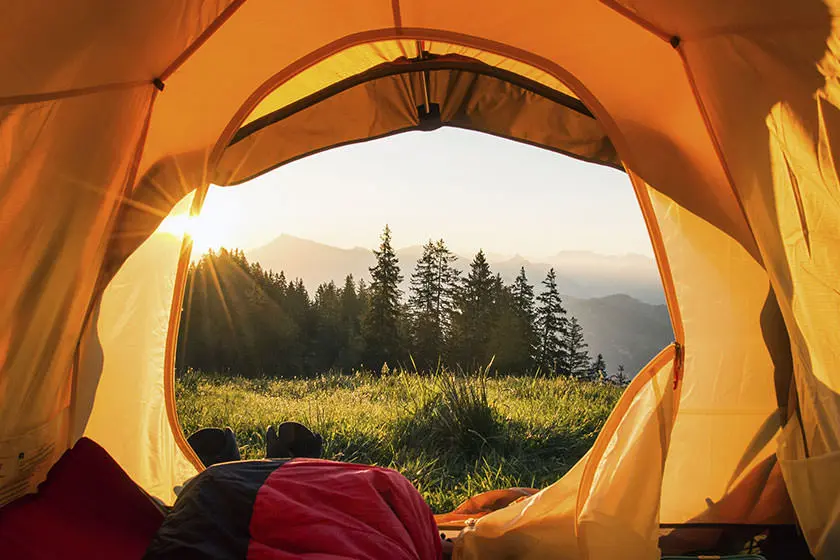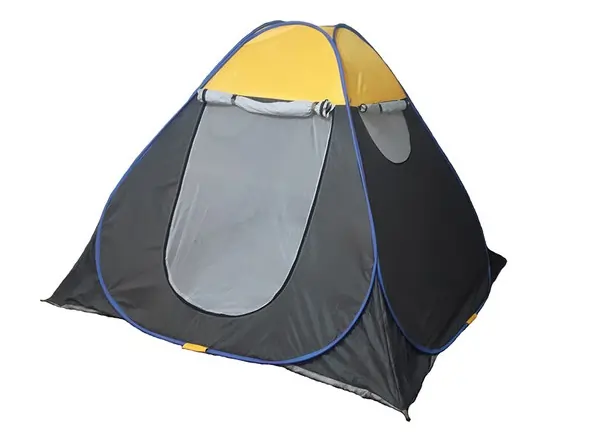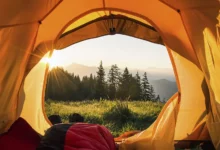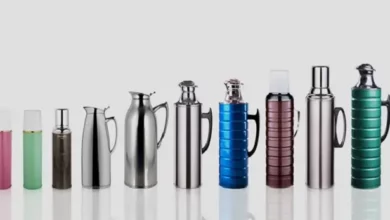Introducing travel tents

Nowadays, travel tents are being produced with diverse structures, appearances, and applications, offering you a wide range of options depending on your recreational, nature exploration, or mountaineering trips.
What are the types of travel tents?
Spring tents, pole tents, automatic tents, compartmentalized travel tents, dome tents, tunnel tents, canopy tents, geodesic tents, and inflatable tents are some of the types of travel tents available.
Traveling is one of the best forms of recreation that helps rejuvenate and recharge from the fatigue of daily life. Some individuals prefer to have a travel tent instead of booking hotels and using the provided facilities, allowing them to camp at suitable locations.
A travel tent has the advantage of significantly reducing travel expenses, enabling multiple trips with a limited budget. Additionally, during hiking and nature exploration, you can have an unforgettable experience without worrying about shelter and resting places. In this article, we aim to provide you with comprehensive and useful information about travel tents. So, stay tuned with Nabtrip travel magazine.
Types of Travel Tent Models
Travel tents are divided into various models based on their installation type, including pole tents, automatic tents, and spring tents.
Spring Tents
Spring travel tents have quick and easy installation. Since the poles are sewn to the main body of the tent, setting them up requires no special expertise. You just need to place the tent on a flat surface and open it up for it to stand. These tents are available in capacities ranging from 6 to 12 people and come in various colors. Due to their lower durability in unfavorable weather conditions, they are often used for lightweight camping and mild climates. These tents are also lightweight and easy to carry.

Pole Tents
Pole travel tents are another type that takes relatively more time to set up but offers high capacity, resistance, and strength. If the tent design has poles that intersect each other in a crisscross pattern, it provides more resistance against pressure, impact, and strong winds. Pole tents are often sold with capacities ranging from 2 to 12 people, and since the structure of their poles resembles blind canes, they are known by that name. There is a wide variety of pole tents available, including small and large sizes.
These travel tents have compact packaging volumes, making them a good choice for professional hikers and nature enthusiasts, as they can easily fit into a backpack. Additionally, due to the lightweight nature of the connectors, this tent model is a suitable option for long-distance travel.
Automatic Tents
Automatic travel tents are among the most popular tents, as they not only allow for easy installation but also offer a variety of models that give you the freedom to choose the tent that suits your needs. These types of tents often have a greater height and a raised ceiling, allowing you to comfortably stand inside and have a more spacious and open environment. The strength of automatic tents is superior to pole tents, thanks to their thicker and steel poles. However, the presence of thicker poles and relatively larger dimensions makes them heavier than pole tents.

Classification of Travel Tents Based on Appearance
Travel tents come in various models in terms of appearance, each with its own functionality in different environments.
Compartmental Tents
Compartmental travel tents are now used for organizing camps and trips with a large number of people. As the name suggests, these tents have multiple compartments, and in addition to the rectangular space used as a living area, they have two doors on the left and right sides for access to the inner compartments of the tent. In fact, different sections of this tent are separated by doors, ensuring the privacy of individuals. This advantage has made this type of tent popular among families.
Geodesic Tents
Geodesic tents have a dome-like appearance and are considered one of the most popular types of travel tents. Due to their high strength and resistance to strong winds, they are a preferable option compared to compartmental tents on stormy days. Despite their suitable height, the sloping walls of these tents hinder comfortable sitting. The floor of these tents can be square or hexagonal in shape, and travelers often use the sides of the walls to place additional items, such as backpacks and clothes, reserving the central area of the tent for sitting and sleeping.
Setting up this type of tent is easy, as you only need to connect two or three flexible arched poles to form the tent’s ceiling. Geodesic tents are lightweight and easily portable. However, they are not suitable for adverse weather conditions and strong winds, and they do not have high durability.
Tunnel Tents
Since maximizing the use of space in geodesic tents was not feasible, manufacturers came up with the idea of creating a tent with a semi-circular structure, resulting in the design of tunnel tents. The presence of circular arches causes the tent walls to form a tunnel shape, making the interior wider compared to many other tents and providing more head and shoulder space. However, tunnel tents generally do not have separate compartments, allowing families to experience memorable trips regardless of privacy.
Tunnel tents come in a variety of sizes, ranging from family tents to specialized camping tents. They are highly resistant to strong and sudden winds and usually require more than one person to set up.
Tent tent
also known as dome tents or ridge tents, are efficient for crowded travel tours. These tents have a dome-like roof and are installed with a horizontal pole along the length of the tent, with two vertical poles at the front and back ends. To ensure the tent’s stability against wind, it is securely fastened to the ground using special ropes. Setting up these tents is very easy, as the poles and main body are connected to the ground through stakes included in the tent’s accessory package, allowing for easy use.
The tent has good resistance to wind and rain, and the sloping design prevents water from pooling on the roof during rain or snow. The tent is usually heavy when packed and can be somewhat challenging to carry over long distances.
Geodesic Tent
Geodesic tents have a dome-like appearance and, as a result, offer ample headroom. These tents use large poles arranged in a crisscross pattern, creating triangles. This distributes pressure across the structure and provides greater resistance to stormy weather conditions and strong winds.
Semi-geodesic tents are also available on the market, featuring a simpler design with fewer poles and, therefore, are lighter. The aerodynamic design of these tents enhances their resistance to wind, making them suitable for camping and mountaineering. Additionally, they have a highly compact packaging volume, making them a convenient option for carrying inside a backpack.
Inflatable Tent
The number of inflatable tents available in the market is very limited, and due to their heavy weight, fewer people are inclined to choose them. Moreover, the high likelihood of damage to the tent’s structure makes it less suitable for recreational purposes and not a good choice for professional camping or hiking. Even the slightest damage to any of the tent’s poles or puncturing it would make it impossible to set up and would require repairs. The advantage of these tents lies in their installation process, which can be done within a few minutes using an air compressor.
Visavis Tent
The Visavis tent is one of the newest travel tents, with its production originating from France. These tents are customizable and feature multiple rooms, with a significant portion of the tent’s interior space dedicated to sleeping compartments located in the middle and around it. Given their heavy weight, it is evident that they are not suitable for professional camping. Their design is aimed at family camping trips, picnics, or any situation where the tent can be transported by vehicle to the campsite.
Pod Tent
Pod tents are among the largest types of travel tents, occupying a substantial amount of space. They consist of a central area and several sleeping compartments. These tent models, considered room tents, provide private spaces for all family members and also include a communal area for family gatherings. Pod tents are quite heavy and not ideal for professional camping, but if you intend to have a picnic or spend the night with your family, they are one of the best options available.
Instant Tent
Instant tents are automatically opened and closed and do not require any special equipment. Although they can be set up very quickly, they are only suitable for favorable weather conditions.
Backpacking Tent
A backpacking tent is easily packed into a backpack due to its lightweight and compact size, making it easy to carry for kilometers. Backpacking tents are commonly used by hikers and mountaineers, mostly as one or two-person tents, although they are also produced in sizes for three or four people.
Buffalo Tent
The Buffalo travel tent is designed with inspiration from nomadic dwellings and resembles a cone-shaped tent. This relatively lightweight tent is easy to install, and due to its compact size, you can easily store it in the trunk of your car.
These tents have good resistance to snow, rain, wind, and extreme heat. They are made of fire-resistant nylon material and are waterproof.
Types of travel tents by application
Three-Season Travel Tents
Most mountaineering travel tents are suitable for use in the three seasons spring, summer, and autumn. Three-season travel tents have at least two mesh windows and are equipped with covers. In addition, they have larger openings on one or both sides that can be opened and closed with zippers. Wide mesh panels for increased airflow and insect prevention, a high and dark interior ceiling, and lightweight fabric and minimal poles are among the features of these tents.
Three to Four-Season Travel Tents
Three to four-season travel tents, designed for the three seasons of spring, summer, and autumn, have one or two additional poles compared to three-season tents for added structural strength. They also have fewer mesh windows to prevent heat loss. Mountaineers often use three to four-season travel tents, although they are not suitable for camping in heavy snow.
Four-Season Tents
Four-season tents have good resistance to heavy snow and storms and generally have more poles and, therefore, weigh more compared to other travel tents. The dome-shaped roof of these tents prevents snow accumulation, and they have a cover to prevent snow or rain from entering the tent. Four-season tents have fewer mesh panels and sometimes feature zippered fabric panels that can be pulled over the mesh panels when needed.
How to Install a Travel Tent
Automatic Pop-Up Tents
Automatic pop-up travel tents are very easy to set up, especially since the poles are connected to each other, and they automatically spring into shape. These tents come in two types: dome-shaped and telescopic.
To install a dome-shaped automatic travel tent, hold the top section of the tent and guide the poles upwards. Then, secure the top section poles to the main poles. Telescopic travel tents are similar in installation to dome-shaped tents, except you need to pull the top section poles upward. Then, connect the lower body poles to the upper ones. All of these steps can be done within a minute, and the ease of installation has made travelers gravitate toward purchasing this type of tent.
Pole-supported Tent Installation
First, take the tent out of the bag and press the poles together to form a tall pole. In the next step, lay the travel tent on the ground like a mat, with the tent floor touching the ground. In this position, you will see a narrow channel where the tent poles will go through. Insert the poles from one corner of this channel and bring them out from the other end. This way, the two main poles of the tent will take shape. Secure both ends of the poles in the designated locations on the sides of the tent to create a curved shape and set up the tent.
Now, tighten the poles that meet at the center of the tent’s roof to form the central part of the tent’s ceiling. Finally, depending on the type of tent, you can use the same method to install the fasteners. Then, use stakes to secure the corners of the tent to the ground for added stability.
Installation of a Spring-loaded Travel Tent
Installing a spring-loaded travel tent is very simple, but it needs to be done correctly to avoid damaging the poles and compromising the safety and balance of the tent.
First, choose a suitable location with a flat surface to set up the tent. A flat surface will ensure that you don’t have any trouble placing your belongings on the ground and that the tent remains balanced. Take the tent out of its carrying bag and unfold it to form a triangle shape. Then, open up the layer that is tucked inside the side layers to turn the tent into a square shape and make it ready for use. For added stability, you can connect the four corner loops with ropes and stakes to secure them to the ground.
How many people should a suitable tent accommodate?
You should choose a tent capacity based on the number of people you usually travel with. Since every gram of weight is crucial during travel, especially in activities like hiking and mountaineering, try to minimize the empty space inside the tent to keep its weight down and make it easier to carry.
Travel tents are typically available in capacities of four, six, eight, ten, twelve, and even twenty people. For example, if you have a family of four and want to have enough space for sleeping and resting, purchase a six or eight-person tent. In fact, the tent capacities are designed based on the assumption of sleeping in them, so for sitting and using the interior space, you should choose a tent with double the capacity of your family size.
If you are bringing a pet with you on your trip, allocate space for them as well. Additionally, consider a section of the tent for storing your belongings. If you are traveling alone, single-person tents and backpacking tents are suitable options.
Mountaineering tents are available in capacities of one to four people and have smaller interiors to save weight and provide better resistance against strong winds. Therefore, choose the tent size based on your height and space requirements.
What should be considered when buying a travel tent?
When buying a travel tent, there are several factors to consider. Here are some important considerations:
1. Size and Capacity: Determine the size of the tent based on the number of people who will be using it. Consider the floor area and headroom to ensure sufficient space for sleeping and moving around comfortably.
2. Weight and Portability: If you plan to carry the tent during your travels, consider its weight and packed size. Look for lightweight and compact options that are easy to transport.
3. Durability and Quality: Check the tent’s construction materials, such as the fabric, poles, and zippers. Ensure they are sturdy, durable, and able to withstand different weather conditions. Look for features like reinforced stitching and waterproof coatings.
4. Weather Resistance: Consider the weather conditions you may encounter during your travels. Look for tents with good waterproofing capabilities, wind resistance, and adequate ventilation to prevent condensation buildup.
5. Setup and Ease of Use: Evaluate the tent’s setup process. Look for tents that are easy to assemble and disassemble, preferably with color-coded or intuitive systems. Quick and hassle-free setup can be crucial, especially when traveling or setting up in unfavorable conditions.
6. Interior Features: Consider additional features that enhance comfort and convenience, such as multiple doors for easy access, vestibules for gear storage, internal pockets for organization, and built-in ventilation options.
7. Price: Set a budget and consider the value for money. Compare prices and features across different brands to find a tent that offers the best balance of quality and affordability.
8. Reviews and Recommendations: Read customer reviews and seek recommendations from experienced travelers or outdoor enthusiasts. Their insights can provide valuable information about the performance and reliability of different tent models.
9. Warranty and Customer Support: Check the warranty provided by the manufacturer. A reliable warranty demonstrates the brand’s confidence in their product. Additionally, consider the availability of customer support or after-sales service in case you need assistance or repairs.
By considering these factors, you can choose a travel tent that meets your specific needs and ensures a comfortable and enjoyable camping experience.
Best Travel Tent Brands
Huski: Huski is one of the most well-known camping gear manufacturers that produces travel tents with high technology and engineering expertise for various weather conditions. These tents are mostly made of polyester, which provides good quality, durability against pressure and impact, and is waterproof. Nowadays, many mountaineering federations and even amateur individuals in different countries use Huski brand tents because their design is suitable for mountainous conditions.
Coleman: Coleman is an American brand that has a long history of producing high-quality travel tents. The distinctive features of Coleman travel tents include sturdy seams, waterproof properties, solid stitching, quality fabric, aesthetics, wind resistance, easy installation, separate compartments to accommodate two families in one tent, and more.
Ferinno: Ferinno is another manufacturer of camping gear and travel tents that started its operation in 1870 and continues to enhance the quality of its products through modern knowledge. This Italian company produces high-quality and waterproof travel tents made of polyester, which have good resistance against pressure, impact, and water penetration.
Kovea: Kovea is a global brand in the field of travel tent production that entered the camping equipment manufacturing scene in 1982 and has gained worldwide recognition in recent years. Kovea tents from Korea have high resistance against pressure, impact, and deformation, and they are also waterproof due to the use of polyester. Some of their products have waterproof capabilities, so it is important to pay attention to this aspect when making a purchase.
Black Diamond: If you are looking for a well-known American brand for travel tents, Black Diamond offers exceptional products in the camping industry. Established in 1957, this company is one of the oldest and most successful brands in producing travel tents. Their high-quality tents are suitable for mountainous and desert environments. The tent poles are made of aluminum and fiberglass, making them the best choice for harsh and stormy weather conditions.
Easycamp: The Danish brand Easycamp has gained a large following by producing high-quality and affordable travel tents. They are pioneers in producing family camping tents.
Other international brands: Columbus, an American company, produces family travel tents; Bestway, a reputable manufacturer, produces mountaineering and professional travel tents; King Camp, a company specialized in travel and camping equipment production; Yamaha, Shengyuan, and Samsung are also among the best travel tent brands.






